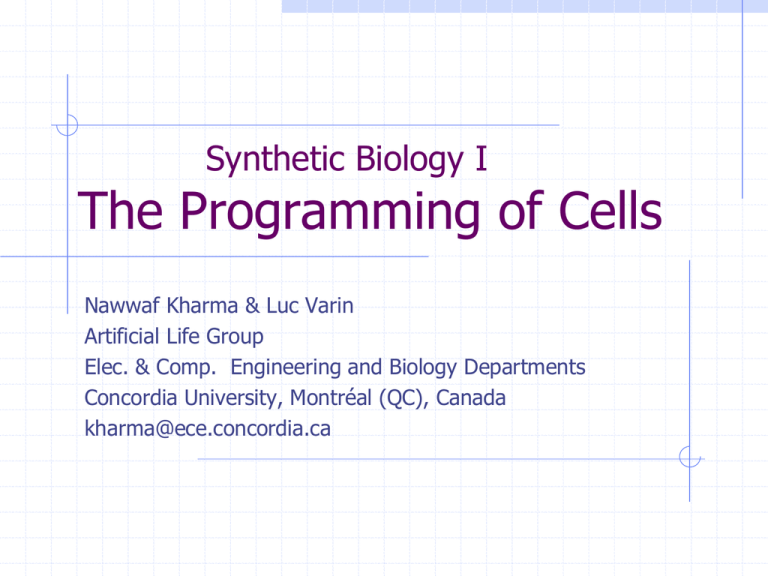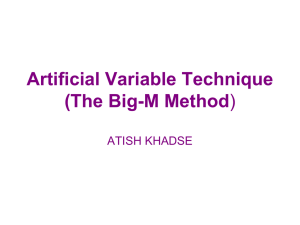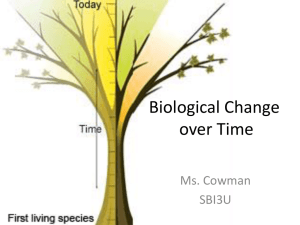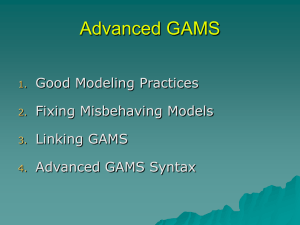TheProgrammingOfCellsTutorial
advertisement

Synthetic Biology I The Programming of Cells Nawwaf Kharma & Luc Varin Artificial Life Group Elec. & Comp. Engineering and Biology Departments Concordia University, Montréal (QC), Canada kharma@ece.concordia.ca Synthetic Biology- What & Why • It is an emerging area of research that combines science and engineering to envision, design and realize novel structures and functions (mainly in cells) by (primarily) modifying the genome (within the cells) • Cells have advantages: • They have/can have built-in interfaces, to sense and produce many substances • They are easy to mass produce, store and distribute • They are generally more robust than man-made systems • They are optimizable via directed evolution Artificial Life Group The Programming of Cells 2 Biological Refresher: Flow of genetic information DNA Transcription RNA RNA Translation Protein Proteins Can interact with each other Artificial Life Group The Programming of Cells 3 Basic Paradigm: From the ground up • First: Basic Components Combinatorial & Sequential • Second: Larger Circuits With more/larger components and/or more functionality • Third: Communications & Pattern Formation Leading to even greater functionality >> Finally, future Challenges that must be met if the field is to advance >>> Artificial Life Group The Programming of Cells 4 Combinatorial Components I: Promoter-based Regulation Artificial Life Group The Programming of Cells Kaern et al. (2003) 5 Combinatorial Components II: siRNA-based Regulation Artificial Life Group The Programming of Cells Deans et al. (2007) 6 Combinatorial Components III: Ribozyme-based Regulation Artificial Life Group The Programming of Cells Win et al. (2008) 7 Sequential Components I: First Toggle Artificial Life Group The Programming of Cells Gardner et al. (2000) 8 Sequential Components II: Various Oscillators Artificial Life Group The Programming of Cells Elowitz et al. (2000) Wong et al. (2006) 9 Sequential Components III: Mammalian Memory Artificial Life Group The Programming of Cells Ajo-Franklin et al. (2007) 10 Sequential Components IV: Pulsers & Delays Delays using repressors only- how? Artificial Life Group The Programming of Cells Kaesling et al. (2006) 11 Summary 1 of 3 Combinatorial Components include: Switches Inverters Logic Gates Sequential Components include: Oscillators (ON-OFF-ON-OFF-…) Toggles (ON or OFF, depending on Input & State) 1-bit Memory (ON or OFF, depending on Input) Pulse-rs (ON for a short while, then auto-OFF) Delays (Output follows Input after a Delay) Next: Scale-up & combine components to build circuits Artificial Life Group The Programming of Cells 12 Larger Circuits I: Combinatorial Logic Artificial Life Group (4 inputs/1 output) The Programming of Cells Rinaudo et al. (2007) 13 Artificial Life Group The Programming of Cells Rinaudo et al. (2007) 14 Larger Circuits II: Sequential Logic (multi-bit memory) Artificial Life Group The Programming of Cells Ham et al. (2008) 15 Larger Circuits III: Modular Design (- also involving intercellular communication) Artificial Life Group The Programming of Cells Kobayashi et al. (2004) 16 Summary 2 of 3 Ex1: Larger Combinatorial Circuit with: Multi-input Logic Function with 4 (and 5) inputs and 1 output Ex2: Multi-bit Memory that: Set precisely using a series of inputs Grows exponentially with no. of invertases Ex3: Modular Circuit with: 3 intra-cellular modules that Sense, Process, and Output information It also communicates with other cells Artificial Life Group The Programming of Cells 17 Advanced Topics I: Pattern Formation (using inter-cellular communications) Artificial Life Group The Programming of Cells Basu et al. (2005) Bernhardt et al. (2007) 18 Advanced Topics II: Inter-kingdom Communications (using another kind of inter-cellular communications) Artificial Life Group The Programming of Cells Weber et al. (2007) 19 Advanced Topics II continued Inter-kingdom Communications Artificial Life Group The Programming of Cells Weber et al. (2007) 20 Advanced Topics III: Applications Artificial Life Group The Programming of Cells Rodrigo et al. (2007) 21 Summary 3 of 3 Ex1: Pattern Formation Is necessary for autonomous differentiation of large collections of cells Ex2: Inter-cellular Communications Is necessary for coordinated action by larger collections of cells Ex3: Applications Necessary to justify the significant cost of investment in “blue-sky” research Artificial Life Group The Programming of Cells 22 Future Challenges I: Reliable WellCharacterized Modules Artificial Life Group The Programming of Cells Canton et al. (2008) 23 Future Challenges II: Synchronization & Communications How can a large number of components communicate and work synchronously across large distances? Possible answers include: A. A large number of freely-diffusing signals B. A much smaller number of shortdistance signals C. Isolated channels (e.g. neurons) that pass signals As to operating synchronously: simulations have been made but no implementations yet! Artificial Life Group The Programming of Cells Garcia-Ojalvo et al. (2004) 24 Future Challenges III: Interfacing with Electro/Optical Components How can electronic devices be interfaced to the new cellular devices? Possibilities include: A. Light at different frequencies B. Electric field C. Chemical reactions, such as: A mammalian cell-based frequency generator: DC power converts ethanol into acetaldehyde, which dose-dependently triggers expression of the BMP-2 in engineered rat cardiomyocytes (AIRNRC-BMP-2) and increases the contraction frequency Artificial Life Group The Programming of Cells Weber et al. (2009) 25 Final Summary Cells are not like human-engineered machines Cells, if fully understood, may be treated as machines Cells are not fully understood or characterized Researchers are starting to see potential in manipulating the genome of cells And they are continuing to expand the frontier while simultaneously improving the reliability of existing components There has been great progress, but still more needs to be done to: A. Build a basic repertoire of reliable well-characterized combinatorial & sequential components B. Communicate and synchronize across large distances and in different mediums C. Establish controllable methods for growing large patterns of inter-acting cells Artificial Life Group The Programming of Cells 26 Artificial Life Group The Programming of Cells 27 References Kaern et al. (2003): Mads Kærn,William J Blake, and J J Collins. “The Engineering of Gene Regulatory Networks.” Annual Review of Biomedical Engineering 5:179–206. Deans et al. (2007): Tara L Deans, Charles R Cantor & James J Collins. “A Tunable Genetic Switch Based on RNAi and Repressor Proteins for Regulating Gene Expression in Mammalian Cells.” Cell 130, 363–372. Win et al. (2008): Maung Nyan Win & Christina D Smolke. “Higher-Order Cellular Information Processing with Synthetic RNA Devices.” Science vol. 322, 456-460. Gardner et al. (2000): Timothy S Gardner, Charles R Cantor & James J Collin. “Construction of a genetic toggle switch in Escherichia coli.” Nature vol. 403, 339-342. Elowitz et al. (2000): Michael B Elowitz & Stanislas Leibler. “A synthetic oscillatory network of transcriptional regulators.” Nature vol. 403, 335- 338. Wong et al. (2006): W W Wong and J C Liao. “The design of intracellular oscillators that interact with metabolism.” Cell. Mol. Life Sci. vol. 63:1215–1220. Ajo-Franklin et al. (2007): Caroline M Ajo-Franklin, David A Drubin, Julian A Eskin, Elaine P S Gee, Dirk Landgraf, Ira Phillips & Pamela A Silver. “Rational design of memory in eukaryotic cells.” Genes and Development 21:2271–2276. Kaesling et al. (2006): http://keaslinglab.lbl.gov/wiki/index.php/Synthetic_Biology__Devices_-_Pulse_Generator Rinaudo et al. (2007): Keller Rinaudo, Leonidas Bleris, Rohan Maddamsetti, Sairam Subramanian, Ron Weiss & Yaakov Benenson. “A universal RNAi-based logic evaluator that operates in mammalian cells.” Nature Biotechnology vol. 25, No. 7: 795-801. Artificial Life Group The Programming of Cells 28 References continued Ham et al. (2008): Timothy S Ham, Sung K Lee, Jay D Keasling & Adam P Arkin. “Design and Construction of a Double Inversion Recombination Switch for Heritable Sequential Genetic Memory.” PloS ONE, vol. 3, No. 7: 1-9. Kobayashi et al. (2004): Hideki Kobayashi, Mads Kærn, Michihiro Araki, Kristy Chung, Timothy S Gardner, Charles R Cantor & James J Collins. “Programmable cells: Interfacing natural and engineered gene networks.” PNAS vol. 101, No. 22: 8414–8419. Basu et al. (2005): Subhayu Basu, Yoram Gerchman, Cynthia H Collins, Frances H Arnold & Ron Weiss. “A synthetic multicellular system for programmed pattern formation.” Nature, vol. 434: 1130-1134. IET Synth. Biol., vol. 1, no. 1–2: 29–31. Bernhardt et al. (2007): K Bernhardt, E J Carter, N S Chand, J Lee, Y Xu, X Zhu, J W Ajioka, J M Goncalves, J Haseloff, G Micklem and D Rowe. “New tools for self-organised pattern formation.” Weber et al. (2007): Wilfried Weber, Marie Daoud-El Baba & Martin Fussenegger. “Synthetic ecosystems based on airborne inter- and intrakingdom communication.” PNAS, vol. 104, no. 25: 10435–10440. Rodrigo et al. (2007): G Rodrigo, A Montagud, A Aparici, M C Aroca, M Baguena, J Carrera, C Edo, P Fernandez-de-Cordoba, A Ferrando, G Fuertes, D Gimenez, C Mata, J V Medrano, C Navarrete, E Navarro, J Salgado, P Tortosa, J Urchueguia and A Jaramillo. “Vanillin cell sensor.” IET Synth. Biol., vol. 1, no. 1–2: pp. 74–78. Artificial Life Group The Programming of Cells 29 References continued Alexic et al. (2007): J Aleksic, F Bizzari, Y Cai, B Davidson, K de Mora, S. Ivakhno, S L Seshasayee, J Nicholson, J Wilson, A Elfick, C French, L Kozma-Bognar, H Ma & A Millar. ” Development of a novel biosensor for the detection of arsenic in drinking water.” IET Synthetic Biolology, vol. 1, no. 1–2: 87–90. Canton et al. (2008): Barry Canton, Anna Labno & Drew Endy. “Refinement and standardization of synthetic biological parts and devices.” Nature Biotechnology, vol. 26, no. 7: 787-793. Garcia-Ojalvo et al. (2004): Jordi Garcia-Ojalvo, Michael B Elowitz, and Steven H Strogatz. “Modeling a synthetic multicellular clock: Repressilators coupled by quorum sensing.” PNAS, vol. 101, no. 30: 10955–10960. Weber et al. (2009): Wilfried Weber, Stefan Luzi, Maria Karlsson, Carlota Diaz SanchezBustamante, Urs Frey, Andreas Hierlemann & Martin Fussenegger. “A synthetic mammalian electro-genetic transcription circuit.” Nucleic Acids Research, vol. 37, no. 4. Artificial Life Group The Programming of Cells 30






